SUMMARY
This is AI generated summarization, which may have errors. For context, always refer to the full article.
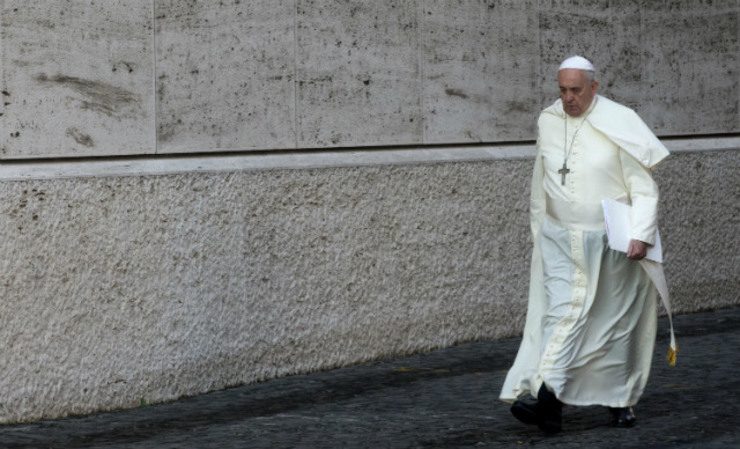
MANILA, Philippines – Popes elected to the Vatican have followed certain traditions that have been passed on and observed through the years.
While some popes managed to follow the prescribed attire and decorations, others paved the way for slight deviations.
As for Pope Francis, here’s what he chose to adopt as soon as he assumed the position in the Holy See.
In some celebrations, Pope Francis would be seen wearing something like this:
 Photo of Pope Francis during an Easter vigil mass from Shutterstock
Photo of Pope Francis during an Easter vigil mass from ShutterstockPart of the pope’s wardrobe here is the pallium – a narrow band with a loop in the center resting on the pope’s shoulders, and with tails at the front and at the back. It is decorated with 6 crosses, one on each tail and 4 on the loop. It has 3 jeweled gold pins, symbolizing the 3 nails used during the crucifixion of Jesus Christ. The pallium – woven from white lamb’s wool – symbolizes for the wearer the “Good Shepherd” who carries sheep over his shoulder.
The pallium is worn over the chasuble, the outermost vestment that is similar to a poncho. Its color depends on the color associated with specific Church celebrations (violet for Lent and Advent, white for Christmas, red for Palm Sunday, etc).
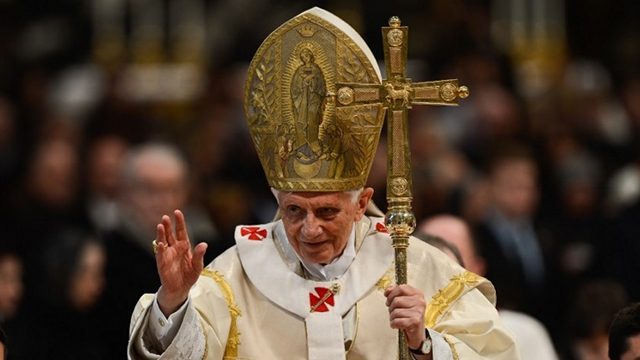
The pope is usually seen holding a papal ferula – a long rod with a cross on top, which symbolizes the holder’s authority and responsibility to tend his sheep. During his inauguration, Pope Francis was seen with the ferula used by Pope Benedict XVI – a golden crossier topped with a cross. (see image at the left) But he later on reverted to the use of the old ferula – a silver one with a crucifix.
Popes also wear a gold Fisherman’s Ring with an image of St Peter (referred to in the Bible as “a fisher of men”) casting his nets, and with the pope’s chosen name inscribed. The ring is a sign of his authority, and was even used in the past to create the wax seal for papal decrees. Each pope carries a distinct ring, and is destroyed upon his death or resignation.
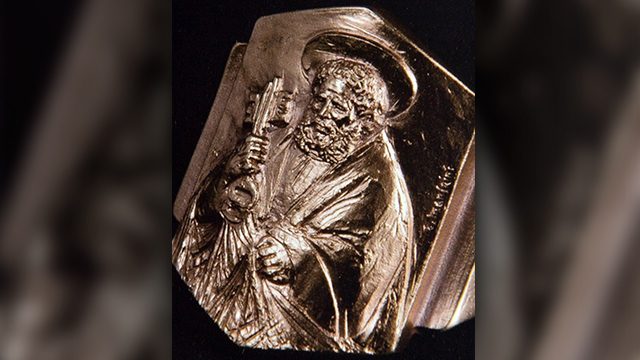
Pope Francis’ ring, compared to the old rings, is made of gold-plated silver. (see image at the left) It was made from the wax cast of a ring supposedly made for Pope Paul VI but was never created. The former personal secretary of Pope Paul VI kept the wax cast and gave it to Monsignor Ettore Malnati, who later on made the ring that was offered to Pope Francis.
As headgear, the pope wears a miter – a tall folding cap with two tails hanging down from the back being worn by popes and cardinals. Pope Francis is said to be wearing the same one he used when he was still a cardinal in Argentina. He reportedly opted to wear a simple miter, as compared to the jewel-adorned miter worn by previous popes.
For other occasions, he would be seen wearing this:
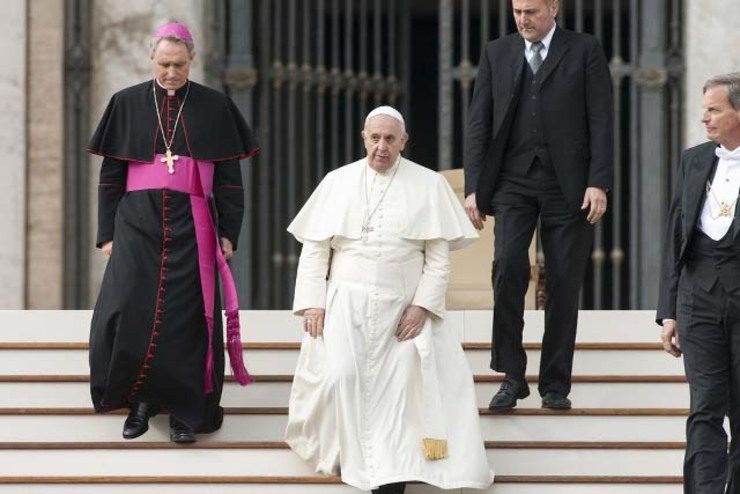 Photo of Pope Francis at St. Peter’s Square from Shutterstock
Photo of Pope Francis at St. Peter’s Square from ShutterstockHis ordinary dress include a white soutane or cassock – an unadorned long-sleeved, hoodless, ankle-length robe – with attached pellegrina (the wing-like flaps hanging from the shoulders). On his head is a white zucchetto.
Fastened around the waist is the fascia, a white sash-like belt with the ends falling down past the knee on one side. It is usually embroidered with the Pope’s coat of arms. However, Pope Francis opted not to have his coat of arms in his fascia.

Despite the lack of design on his fascia, Pope Francis still has a coat of arms (see image at the left). It features a blue shield with 3 elements that show his devotion to the Holy Family: the logo of the Jesuits (Society of Jesus) to which Pope Francis belongs to, a star symbolizing the Virgin Mary on the lower left, and a spikenard flower symbolizing St Joseph on the lower right. Behind the blue shield are the crossed keys of St Peter – a gold key signifying power in Heaven, and a silver key signifying authority on earth – joined by a red cord to represent the bond between the two powers.
On top of the shield is the papal miter. Previous popes use in their coat of arms a beehive-shaped 3-tiered tiara, until Pope Benedict XVI put it on his a miter. The silver miter has 3 gold stripes to mirror order, jurisdiction and magisterium, all connected in the middle by a vertical gold band to signify their unity in the same person.
Inscribed below the coat of arms is his chosen motto – Miserando atque eligendo (“lowly but chosen”; literally in Latin, “by having mercy, by choosing him”). It was lifted from the Gospel account where St Matthew was called for the vocation: Vidit ergo Jesus publicanum, et quia miserando atque eligendo vidit, ait illi, “Sequere me” (Jesus therefore sees the tax collector, and since he sees by having mercy and by choosing, he says to him, “Follow me”). This line has a special significance to Pope Francis. In 1953, on the Feast of Saint Matthew, a 17-year-old Jorge Bergoglio felt the call to religious life.
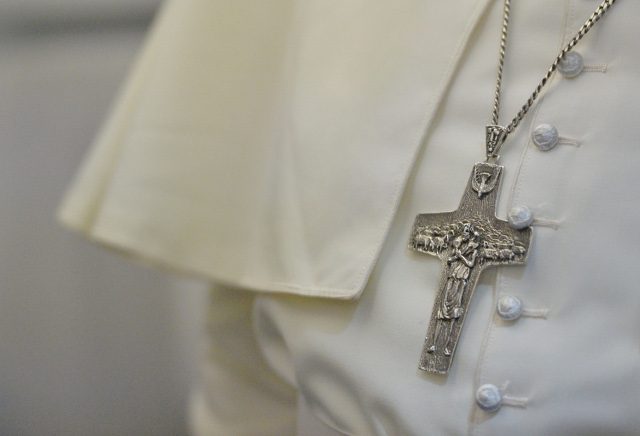
Pope Francis also wears a pectoral cross – traditionally worn by popes, cardinals, and bishops on a chain or cord necklace. (see image at the left) Popes usually wear pectoral crosses made of gold and usually adorned with jewels and precious stones. But Pope Francis opted to wear the old, unadorned silver cross he received as a gift from a friend when he was still an archbishop in Argentina.
His silver cross shows the image of a barefoot and simply-dressed Jesus Christ holding a lamb around His shoulders as He leads a flock of sheep, which symbolizes the pope’s legacy as the “good shepherd”.
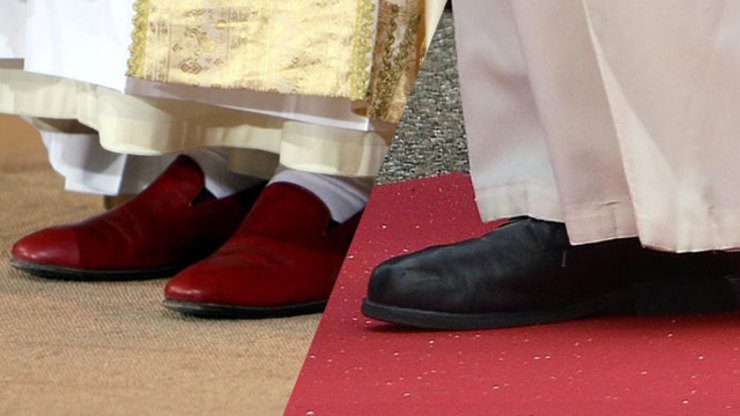
Pope Francis was often described as very simple with his choice of vestment, and was often compared to the outfit chosen by Pope Benedict XVI. Aside from his simple ring and cross, observers also noted that Pope Francis opted to wear simple black shoes, as compared to the red papal shoes worn by his predecessor (see image at the left). – Rappler.com
Sources: Official Vatican Network, Vatican City website, Catholic News Service, Wikipedia, various news websites
Add a comment
How does this make you feel?
There are no comments yet. Add your comment to start the conversation.